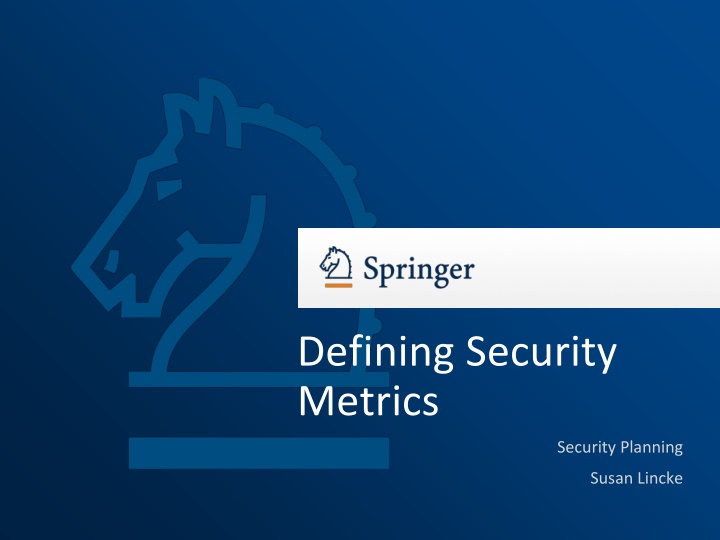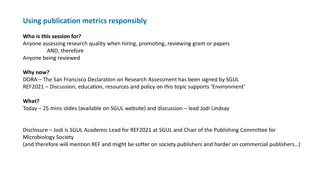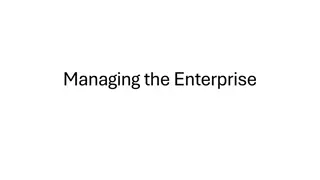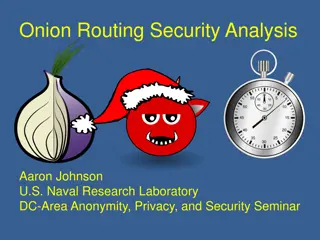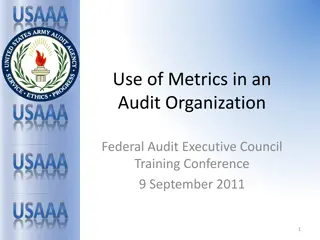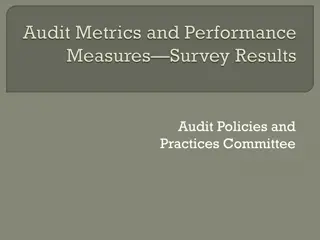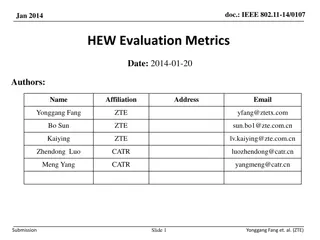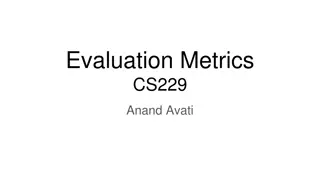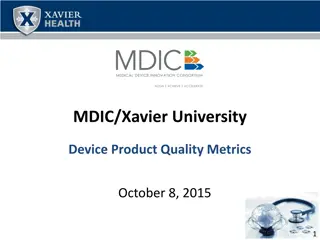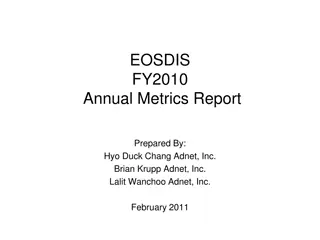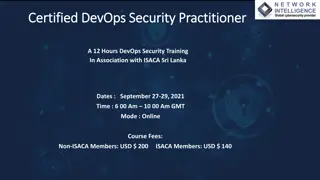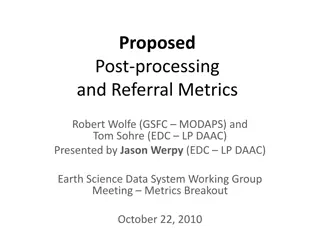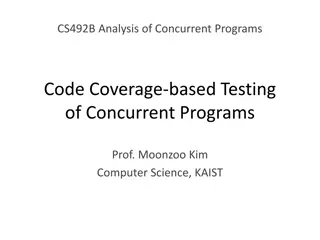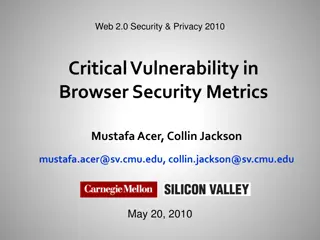Defining Security Metrics
This overview delves into security planning strategies, key concepts like KGI and KPI, Zero Trust Principles, gap analysis, and SEI/COBIT Level 4 monitoring. Explore how metrics inform security program effectiveness and goal achievement.
Download Presentation

Please find below an Image/Link to download the presentation.
The content on the website is provided AS IS for your information and personal use only. It may not be sold, licensed, or shared on other websites without obtaining consent from the author.If you encounter any issues during the download, it is possible that the publisher has removed the file from their server.
You are allowed to download the files provided on this website for personal or commercial use, subject to the condition that they are used lawfully. All files are the property of their respective owners.
The content on the website is provided AS IS for your information and personal use only. It may not be sold, licensed, or shared on other websites without obtaining consent from the author.
E N D
Presentation Transcript
Defining Security Metrics Security Planning Susan Lincke
Security Planning: An Applied Approach | 3/16/2025| 2 SABSA High-Level Framework
Security Planning: An Applied Approach | 3/16/2025| 3 Key Concepts: Business Metrics Key Goal Indicators (KGI): Is management achieving strategic goals for the organization? a goal may be regulatory compliance: where we are versus where we should be. Key Performance Indicators (KPI): A defined goal may be broken down into factors or steps to achieve that goal. How are performing relative to these factors or steps? Key Risk Indicators (KRI): Monitoring high priority risks: Indicate a probability or trend of the actual status of risks Provide a more accurate guide for the future, to help meet strategic goals. Evaluate past performance, e.g., to learn about actual risk appetite.
Security Planning: An Applied Approach | 3/16/2025| 4 Zero Trust Principles (Review: related to Metrics) Access to resources is determined by a dynamic policy: Risk is evaluated based on multiple factors, such as client identity, service requested, asset configuration, past history and other situational factors. The enterprise monitors and measures the integrity and security posture of all owned and associated assets: All devices and assets must be monitored for intrusion, vulnerabilities, patching; associated assets include bring-your-own- device The enterprise collects as much information as possible about the current state of assets, network infrastructure and communications and uses it to improve its security posture. Risk must be determined by monitoring the current state of the enterprise network.
Security Planning: An Applied Approach | 3/16/2025| 5 Gap Analysis The difference between where you are and where you want to be: (For example: # malware infections/month Rate of finding illegal software, hardware Security awareness training averages
Security Planning: An Applied Approach | 3/16/2025| 6 SEI/COBIT Level 4 Monitoring: Includes Metrics Metrics inform management (and independent auditors) of the effectiveness of the security program Monitoring achievement of control objective may be more important than perfecting security procedures
Security Planning: An Applied Approach | 3/16/2025| 7 Which metrics to use? Two Approaches Business-Driven Addresses specific business risks Inherent industry risks Tailored to organization Measures adherence to control objectives Technology-Driven Addresses recent threats observed by CERT CERT: Computer Emergency Readiness Team Addresses recent forensic data Business- Driven Technology- Driven
Security Planning: An Applied Approach | 3/16/2025| 8 Business- Driven Technology- Driven ISACA CISA-CISM BUSINESS-DRIVEN METRICS
Security Planning: An Applied Approach | 3/16/2025| 9 Business-Driven Metrics Step 1: What are management s goals and the most important security risks to monitor in your organization? What threats and compliance requirements are of most concern? Review your risk plan and policies to help define the most important areas to monitor. Step 2: Which metrics make the most sense to collect and monitor. Since automated metrics are doable in a busy world, can these metrics be automatically collected? Step 3: Consider the three perspectives of strategic, tactical and operational metrics, relative to the three audiences.
Security Planning: An Applied Approach | 3/16/2025| 10 Monitoring Function: Business-Driven Metrics Executive mgmt is interested in risk, budget, policy. Review every 6 months-1 year Strategic Metrics Metrics Technical details: E.g., firewall, logs, IPS, vulnerability tests. Review weekly. Automate statistics. Opera- tional Metrics Tactical Metrics Determine effectiveness of security program: risk changes, compliance, incident response tests. Review quarterly to half-year
Security Planning: An Applied Approach | 3/16/2025 | 11 Monitoring Function: Business-Driven Metrics Project Plan or Budget Metrics Risk performance Disaster Recovery Test results Audit results Regulatory compliance results Strategic Metrics Metrics Opera- tional Metrics Tactical Metrics Vulnerability Scan results Server config. standards compliance IDS monitoring results Firewall log analysis Patch mgmt status Policy compliance metrics Exceptions to policy/standards Changes in process or system affecting risk Incident management effectiveness
Security Planning: An Applied Approach | 3/16/2025 | 12 Monitoring Function: Metrics Risk: The aggregate ALE % of risk eliminated, mitigated, transferred # of open risks due to inaction Cost Effectiveness: Cost of workstation security per user Cost of email spam and virus protection per mailbox Operational Performance Time to detect and contain incidents % packages installed without problem % of systems audited in last quarter Organizational Awareness: % of employees passing quiz, after training vs. 3 months later % of employees taking training Technical Security Architecture # of malware identified and neutralized Types of compromises, by severity & attack type Attack attempts repelled by control devices Volume of messages, KB processed by communications control devices Security Process Monitoring: Last date and type of BCP, DRP, IRP testing Last date asset inventories were reviewed & updated Frequency of executive mgmt review activities compared to planned
Security Planning: An Applied Approach | 3/16/2025 | 13 Monitoring Function: Metrics cont d Security Management Framework: Completeness and clarity of security documentation Inclusion of security in each project plan Rate of issue recurrence Compliance: Rate of compliance with regulation or policy Rate of automation of compliance tests Frequency of compliance testing Incident Response Metrics # of Reported Incidents # of Detected Incidents Average time to respond to incident Average time to resolve an incident Total number of incidents successfully resolved Total damage from reported or detected incidents Total damage if incidents had not been contained in a timely manner Secure Software Development: Rate of projects passing compliance audits Percent of development staff certified in security Rate of teams reporting code reviews on high-risk code in past 6 months
Security Planning: An Applied Approach | 3/16/2025 | 14 Metrics Selected Workbook: Metrics What are the most important areas to monitor in your organization? Cracking Attempt Lunatic gunman Major Risks: Ransomware FERPA Violation Web Availability Metric Calculation & Collection Method Information Tech. Group Period of Reporting 1 year Category Cost of security/terminal Cost of incidents % employees passing info security quiz % employees completing info security (& FERPA) training # Hours Web unavailable # illegal packets in confidential zone # malware infections Strategic Incident Response totals Annual email requesting testing 6 months 6 months Tactical One annual training with sign-in. Performance review for key personnel 6 months Incident Response database 3 months Log management database 1 week Operational Incident Response database 1 month
Security Planning: An Applied Approach | 3/16/2025 | 15 Business- Driven Technology- Driven SANS-Recommended Critical Controls for Effective Cyber Defense TECHNOLOGY-DRIVEN METRICS
Security Planning: An Applied Approach | 3/16/2025 | 16 Creating a baseline configuration of network
Security Planning: An Applied Approach | 3/16/2025 | 17 Noticing inappropriate additions to the network New PC New AP New wireless
Security Planning: An Applied Approach | 3/16/2025 | 18 Checking the security configuration of network Patched? Legal software? Firewall on & security configured? Antivirus on and patched? Limit USB access? WPA2 WPA3? Monitor Network? Withstands attacks? SQL, buffer overflow, cross-site scripting, clickjacking,
Security Planning: An Applied Approach | 3/16/2025 | 19 Noticing inappropriate actions New sys admin or user acct Transfer of confidential data or illegal packets Detect new network service
Security Planning: An Applied Approach | 3/16/2025 | 20 SANS: Critical Controls for Effective Cyber Defense Typical SANS Metric: Temporarily install unauthorized software, hardware or configuration on a device. It should be: found within 24 hours (or best: 2 minutes) isolated within one hour confirmed by alert/email reported every 24 hours until issue is resolved.
Security Planning: An Applied Approach | 3/16/2025 | 21 CIS Critical Control 1: Inventory of Authorized Devices Ensure all devices (with IP address) on network are known, configured properly, and patched. Everything with an IP address is inventoried and controlled. inventory includes: IP address, hardware (e.g., MAC) address, machine name, asset owner and department. Tool: Automate network scanning for daily or weekly execution and/or use DHCP reports and passive monitoring. Compare results daily or weekly with known good configurations. Metric: Temporarily install unauthorized device.
Security Planning: An Applied Approach | 3/16/2025 | 22 CIS Critical Control 2: Inventory of Authorized Software Ensure all software is inventoried, approved and recently patched Inventory includes software name, source/publisher, install date, version, deployment mechanism, and applicable license information. Tools: Endpoint Security Suites (ESS) contain antimalware, firewall, IDS/IPS, software allow/blocklisting. Metric: Temporarily install unauthorized software on a device.
Security Planning: An Applied Approach | 3/16/2025 | 23 CIS Critical Control 3: Management of Protected and Sensitive Data Define standards for: data handling retention disposal access permissions encryption logging of accesses monitoring of logs. Metric: Reevaluate inventory annually or with significant changes.
Security Planning: An Applied Approach | 3/16/2025 | 24 CIS Critical Control 4: Secure Configurations for Hardware & Software All devices are hardened using recommended security configurations enable firewalls use encryption, session locking and complex passwords, minimize default accounts, restrict services remotely wipe missing devices Tools: use secure images; configuration checking tools daily Metric: Review secure configurations annually Temporarily attempt to change a set of random configurations.
Security Planning: An Applied Approach | 3/16/2025 | 25 CIS Critical Control 5: Account Monitoring and Control Maintain an inventory of valid accounts, including persons name, user name, start/expiration dates, and department. Remove terminated accounts in a timely manner, via account expiration dates, or logs of expired password accounts, disabled accounts, or locked- out accounts Require unique passwords Avoid using system admin accounts for non-admin work Tools: Operating system tools to generate alerts for the above conditions should be enabled. Metric: Review of accounts quarterly for validity. A list of valid user accounts is collected daily; an alert or email is generated for unusual changes.
Security Planning: An Applied Approach | 3/16/2025 | 26 CIS Critical Control 6: Controlled Access Based on Need to Know Data classification and logging access to confidential data help prevent exfiltration of data to competitors. Separate accounts for email/web access versus privileged access (e.g., administrator). Multifactor authentication used for privileged, e.g., admin accounts Tools: Fine-tuned authentication, role-based access control, multifactor authentication and network zoning. Metric: Unauthorized accesses generate an alert with 24 hours or preferably less time. Revoke or disable terminated accounts within limited time frame
Security Planning: An Applied Approach | 3/16/2025 | 27 CIS Critical Control 7: Continuous Vulnerability Assessment, Remediation Run vulnerability scans on all systems at least weekly, preferably daily. Problem fixes are verified through additional scans. Vulnerability scanning tools (updated) for: wireless, server, endpoint, etc. Automated patch management tools notify via email when all systems have been patched. Metric: Review vulnerability scanning plan annually. Perform patch management at least monthly. Vulnerability notification(s) are emailed within one hour of completion of a vulnerability scan.
Security Planning: An Applied Approach | 3/16/2025 | 28 CIS Critical Control 8: Management of Audit Logs Logs are used to detect and to forensically analyze attacks. Logs include system logs: report on OS and network events audit logs: report on user events and transactions. Logs are write-only, forwarded to a centralized log server, and archived for >= 90 days Tools: Logs are verbose 90 days worth of space is allocated for logs SIEM tools help in analyzing alerts Metric: Ensure the centralized log server is receiving logs from each inventoried device periodically. Log specifications are inspected annually. Time synchronization ensures logs are synchronized. Logs are reviewed at least weekly or more frequently
Security Planning: An Applied Approach | 3/16/2025 | 29 CIS Critical Control 9: Email and Web Browser Protections Primary methods for criminals to enter organization: malware, social engineering, or web. Criminals abuse vulnerabilities within browsers and browser plug-ins Browser software must remains supported and patched pop-ups are disabled Users are trained to recognize and report phishing attempts. Tools: Email filtering can restrict spam, scan for malware, and restrict uncommon file type extensions. Web filters can block potentially dangerous websites. Metric: Periodically ensure blocked websites remain blocked. Test that unauthorized browsers are found and removed. Periodically ensure that unauthorized file types are removed within email
Security Planning: An Applied Approach | 3/16/2025 | 30 CIS Critical Control 10: Malware Defense Malware is used to steal or destroy data, capture credentials, traverse organizational networks, etc. Antivirus/antispyware is always updated Run against all data: shared files, server data, mobile data. Additional controls: blocking social media, limiting external devices (USB), using web proxy gateways, network monitoring. Endpoint security suites report tool is updated and active on all systems Tools: Anti-malware, or endpoint security suites: can report that tool is updated and activated on all systems Metric: For install of benign malware (e.g., security/hacking tool), antivirus prevents installation or execution or quarantines software Sends an alert/email within one hour indicating specific device and owner Antimalware automatically updates itself in a timely manner
Security Planning: An Applied Approach | 3/16/2025 | 31 CIS Critical Control 11: Data Recovery Capability Criminals can alter configurations, programs or data, or demand ransoms, making data unavailable or untrustworthy. Backups are maintained at least weekly and more often for critical data. Backups are encrypted and securely stored. Multiple staff can perform backup/recovery. Metric: Test backups quarterly for a random sample of systems. This includes operating system, software, and data restoration. Recovery documentation is reviewed annually and with changes. Backups are run weekly or more frequently
Security Planning: An Applied Approach | 3/16/2025 | 32 CIS Critical Control 12: Secure Network Configurations A configuration DB tracks approved configurations in config. mgmt. for network devices: firewalls, wireless APs, routers, switches. Communications protocols shall be of recent versions and use encryption. Network software is patched and end-of-life devices are upgraded or include mitigating controls Multifactor identification required for controlling network devices; login to authentication server required to access VPN or organizational devices. Tools: Tools can perform rule set sanity checking for network filter devices, which use Access Control Lists. Network devices implement segmentation. Metric: A network architecture is fully documented and updated at least annually or as the network changes. To test, any change to the configuration of a network device is recognized within 24 hours.
Security Planning: An Applied Approach | 3/16/2025 | 33 CIS Critical Control 13: Network Attack and Log Monitoring Criminals are often in an organization s networks for months before discovery, it is important to be able to detect and track attacks. Threat intelligence skills includes learning to recognize and document attacker techniques: Security Information and Event Management (SIEM), Intrusion Prevention Solution (IPS) must be tuned at least monthly. Filtering between network zones is required to segment networks. Tools: Use security tools or hire security consultants or a managed service provider. HIDS/HIPS, NIDS/NIPS, and application layer firewalls or proxies can catch attacks A centralized log analysis tool (SIEM) aids in analyzing logs Automated port scanning daily/periodically monitors for open services/versions Wireless IPS, vulnerability scanners can detect available wireless APs and trojan AP. Metric: Compare port scanning results daily with known good configurations. To test, temporarily place a secure test service randomly on the network, which will respond to network requests. The system should detect a rogue access point or unauthorized device within one hour or day.
Security Planning: An Applied Approach | 3/16/2025 | 34 CIS Critical Control 14: Security Awareness Skills Assessment Security training is necessary for all end users: executive management often handles more proprietary info. system administrators have privileged system access finance, contracts and human resources have specialized access to information or money software engineers must practice safe programming practices Tools: Annual training and phishing tests Metric: Update social engineering training annually. Test security awareness understanding in training; Attempt periodic social engineering tests using phishing emails and phone calls
Security Planning: An Applied Approach | 3/16/2025 | 35 CIS Critical Control 15: Management of Service Providers Most organizations use 3rd-party agreements, who may use other parties. Contracts should ensure: specific security, privacy and regulatory controls and requirements enable performance monitoring & incident response include contract termination clauses, including data disposal Tools: Third-party assessment platforms can evaluate service providers technical assessment and risk rating Metrics: Annual review of service provider inventory Annual review of contractor certifications and performance
Security Planning: An Applied Approach | 3/16/2025 | 36 CIS Critical Control 16: Application S/W Security New application software is tested for security vulnerabilities: Web vulnerabilities: buffer overflow, SQL injection, cross-site scripting, cross-site request forgery, clickjacking of code, and performance during DDOS attacks. Input validated for size, type No system error messages reported directly to user Standardized utilities include identity management, encryption, and logging. Configuration requires application firewalls, hardened databases, separate developer/production environments. Tools: Automated testing: static code analyzers, automated web scanning tools and automated DB configuration review tools; Security training/standards for programmers: secure design and coding standards, change control tools, software defect severity rating system Metric: An attack on the software generates a log or email in <= 24 hours. Automated web scanning occurs weekly or daily errors are fixed within 15 days. Annual review of inventory of third-party software
Security Planning: An Applied Approach | 3/16/2025 | 37 CIS Critical Controls 17. Incident Response: 18. Penetration Tests: Incident Response Plan (IRP) defines who does what during incidents IRP provides contact information Used to verify and validate proper operation of controls expert outsiders determine level of exploitable vulnerabilities internal penetration testing evaluates where penetration testing should occur for the organization Tools: Incident Response Plan, Communication Plan Metrics: Annually review IRP, personnel roles Perform IR testing at least annually Update thresholds distinguishing events from incidents at least annually or after significant change. Perform post-incident review, update documentation Tools: Rules of engagement specify testing times, duration, and overall test approach. Metric: Perform internal and external pen testing (each) at least annually
Security Planning: An Applied Approach | 3/16/2025 | 38 Question The difference between where an organization performs and where they intend to perform is known as: 1. Gap analysis 2. Quality Control 3. Performance Measurement 4. Benchmarking
Security Planning: An Applied Approach | 3/16/2025 | 39 Question The MOST important metrics when measuring compliance include: 1. Metrics most easily automated 2. Metrics related to intrusion detection 3. Those recommended by best practices 4. Metrics measuring conformance to policy
Security Planning: An Applied Approach | 3/16/2025 | 40 Question SANS recommends that an initial maximum allowable time to detect a problem in a network or server configuration is: 1. Two minutes 2. One hour 3. One day 4. One week
Security Planning: An Applied Approach | 3/16/2025 | 41 Jamie Ramon MD Doctor Chris Ramon RD Dietician Terry Licensed Practicing Nurse Pat Software Consultant HEALTH FIRST CASE STUDY Defining Security Metrics
Security Planning: An Applied Approach | 3/16/2025 | 42 Which metrics to use? Two Approaches Business-Driven Addresses specific business risks Inherent industry risks Tailored to organization Measures adherence to control objectives Technology-Driven Addresses recent threats observed by CERT CERT: Computer Emergency Readiness Team Addresses recent forensic data Business- Driven Technology- Driven
Security Planning: An Applied Approach | 3/16/2025 | 43 Approach 1: Implementing Business-Driven Metrics Step 1: What are management s goals and the most important security risks to monitor in your organization? What threats and compliance requirements are of most concern? Review your risk plan and policies to help define the most important areas to monitor. Step 2: Which metrics make the most sense to collect and monitor. Since automated metrics are doable in a busy world, can these metrics be automatically collected? Step 3: Consider the three perspectives of strategic, tactical and operational metrics, relative to the three audiences.
Security Planning: An Applied Approach | 3/16/2025 | 44 Monitoring Function: Business-Driven Metrics Executive mgmt is interested in risk, budget, policy. Review every 6 months-1 year Strategic Metrics Metrics Technical details: E.g., firewall, logs, IPS, vulnerability tests. Review weekly. Automate statistics. Opera- tional Metrics Tactical Metrics Determine effectiveness of security program: risk changes, compliance, incident response tests. Review quarterly to half-year
Security Planning: An Applied Approach | 3/16/2025 | 45 Metrics Selected Workbook: Metrics What are the most important areas to monitor in your organization? Cracking Attempt Lunatic gunman Major Risks: ransomware FERPA Violation Web Availability Metric Calculation & Collection Method Information Tech. Group Period of Reporting 1 year Category Cost of security/terminal Cost of incidents % employees passing info security quiz % employees completing info security (& FERPA) training # Hours Web unavailable # illegal packets in confidential zone # malware infections Strategic Incident Response totals Annual email requesting testing 6 months 6 months Tactical One annual training with sign-in. Performance review for key personnel 6 months Incident Response database 3 months Log management database 1 week Operational Incident Response database 1 month
Security Planning: An Applied Approach | 3/16/2025 | 46 Approach 2: Implementing Technology-Driven Metrics it is not possible to build a secure network in a day 1. Prioritize three to implement next, knowing that all should be implemented, and potentially assuming some already are. 2. Justify why these 3 metrics are important to your business to prioritize in implementation. 3. Refer to the book or slides for information on each of these metrics and tools.
Security Planning: An Applied Approach | 3/16/2025 | 47 Approach 2: Implementing Technology-Driven Metrics Inventory of Authorized Devices Email and Web Browser Protections Inventory of Authorized and Unauthorized Software Malware Defenses Data Recovery Capability Management of Protected and Sensitive Data Secure Configurations for Network Devices Secure Configurations for Hardware and Software Network Attack and Log Monitoring Security Awareness Skills Training Account Monitoring and Control Management of Service Providers Controlled Access Based on Need to Know Application Software Security Incident Response and Management Continuous Vulnerability Assessment and Remediation Penetration Testing Management of Audit Logs
